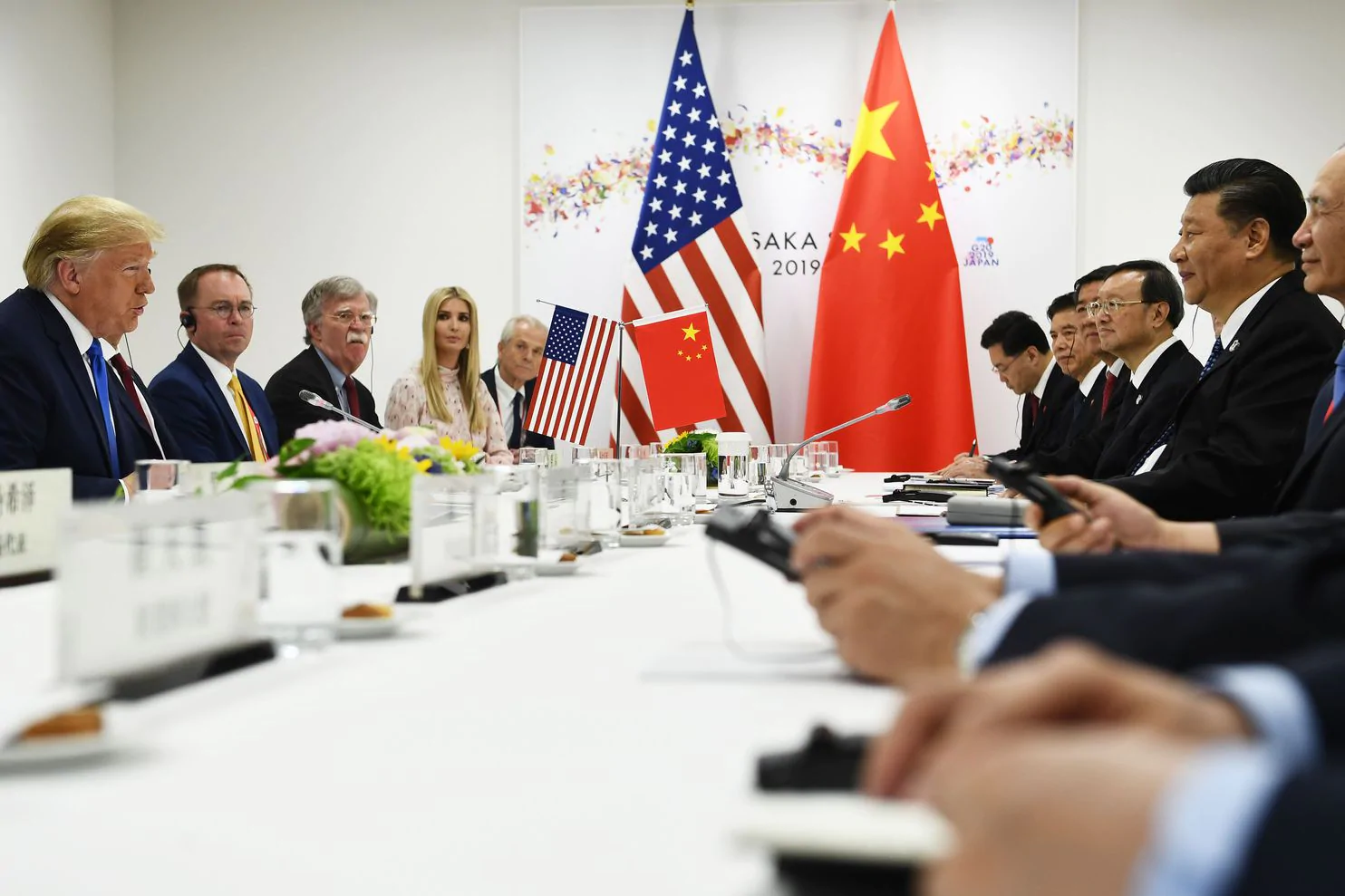OSAKA, Japan — President Trump and Chinese leader Xi Jinping met Saturday and agreed to restart trade negotiations after more than a month of acrimonious fighting, though major issues remain and it’s unclear whether a long-term detente is within reach.
Chinese state media reported that Trump had agreed to delay the imposition of any new tariffs on Chinese goods during the reboot, though it did not say Trump would pull back tariffs that he has already imposed.
“We discussed a lot of things and we’re right back on track,” Trump said after the meeting at the at Group of 20 summit. “We’ll see what happens. We had a really good meeting.”
Trump said he’ll provide more details on the China talks at a news conference later Saturday and that the Chinese will put out their own statement. “We had a very, very good meeting with China, I would say probably even better than expected. And the negotiations are continuing.”
The meeting was being watched closely by business groups, farmers and U.S. political leaders. Some feared a prolonged standoff between two of the world’s most powerful countries could damage the global economy.
Before the meeting, Trump had bemoaned how their previous effort to broker a trade deal appeared to unravel a month ago.
“I actually think we were very close and then something happened where it slipped a little bit,” Trump said, addressing Xi. “Now it’s getting a little closer.”
Trump has accused China of a range of unfair trade practices, including the theft of intellectual property, unfair subsidies and currency manipulation, among other things. Some of his allegations aren’t backed up by data, but a range of experts and U.S. political leaders have agreed that China has violated trade rules to win an advantage over U.S. companies.
The future of these talks could have major economic consequences for both countries, and political consequences for Trump. The U.S. president has already had to dispatch more than $20 billion in payments to farmers to quell a rebellion from many who had alleged they were caught in the midst of the trade war.
Reading off a piece of paper when reporters were in the room, Xi was careful not to reveal his strategy in dealing with the U.S. leader.
“Cooperation and dialogue is better than friction and confrontation. Today, I’m prepared to exchange views on the fundamental issue of the growth of the U.S.-China relations to set the direction of our relationship in the period to come.”
Some White House officials had hoped the meeting would serve as a way to restart negotiations that had begun in earnest last year only to unravel more than a month ago when White House officials accused the Chinese of backtracking on some commitments. Chinese officials responded by saying they had not agreed to the things the White House officials had alleged.
Xinhua News, a state-run entity, reported after Trump’s meeting with Xi that the U.S. would hold off on imposing new tariffs because talks had resumed. Trump had threatened to slap a 25 percent tariff on more than $300 billion in Chinese imports, but he had suggested he might delay these if talks restart. Trump has already imposed tariffs on $250 billion in Chinese imports, a measure that other world leaders have alleged is damaging the global economy.
Trump has also said he is willing to ease up on his recent crackdown against Huawei, a giant Chinese technology company, as part of any talks.
The meeting came on the sidelines of the Group of 20 summit, and neither leader appeared to be eager to soften their previous position to cut a deal. The two men also met Friday night, and Trump had expressed optimism that they might be able to come to an agreement.
“We’ll be discussing a lot of things,” Trump said shortly before the Saturday meeting. “I was with him last night. A lot was accomplished actually last night. As to whether or not we can make a deal, time will tell.”
A number of top White House officials sat in on the Saturday meeting, including U.S. Trade Representative Robert E. Lighthizer, Secretary of State Mike Pompeo, Treasury Secretary Steven Mnuchin and top trade adviser Peter Navarro.
Trump has accused China of ripping off U.S. intellectual property and stealing U.S. jobs, while the Chinese have countered that Trump is trying to bully them and not allowing the talks to be set on an equal footing. Chinese officials have also accused the White House of trying to strong-arm them to purchase billions of dollars in U.S. agriculture goods.
Trump’s decision to temporarily postpone — it’s unclear for how long — any new tariffs against Chinese imports could offer short-term relief to hundreds of U.S. businesses, which have petitioned the White House to be exempted because they say there would be massive costs to their companies.
Tariffs are a type of tax paid by companies that import products, and many firms have asked the Commerce Department to be exempted from new tariffs because they say they can’t import the products from elsewhere. Trump has said this hard-line tactic with China is the only way to try to force the country to change its trade practices, and he has also said the billions of dollars in tariff revenue that the United States has reaped in the past year validates his approach.
It’s unclear where the talks might go. Both leaders have shown a willingness to let the fight drag on for much longer, though Trump could face political pressure to wrap up the standoff soon, given concerns about the strength of the U.S. economy and his reelection bid next year.
Trump imposed tariffs on numerous Chinese goods last year, and these penalties grabbed the attention of Xi and others. During the G-20 summit in Argentina in December, Trump and Xi agreed to begin negotiations to resolve trade differences. While the two countries were negotiating, Trump agreed to hold off on further tariffs.
But talks broke down more than a month ago, and Trump swiftly moved to toughen tariffs and propose new ones. Trump’s existing tariffs on Chinese goods cover a range of business products, industrial equipment and many consumer goods. But his proposed tariffs would hit everything else, including many electronics and consumer products, and businesses have warned those costs would be passed along to U.S. consumers.
Trump last week said he was considering levying a 10 percent tariff on this final batch of products, which he estimated to cover more than $300 billion in goods.
Again and again during his presidency, he has turned to tariffs as a way to try to force other countries to cut a deal. He has called himself a “Tariff Man,” despite a long-standing GOP push to embrace free trade and reduce import and export barriers.
When the United States and China were negotiating the trade deal earlier this year, White House officials were focused on a 150-page document that they felt captured the necessary changes they wanted to see from the Chinese government to rebalance the economic relationship.
The document would have addressed China’s currency policy, its government support for private companies, its insistence that U.S. companies transfer technology to the Chinese, and the theft of intellectual property. The White House has also pushed China to stop dumping lower-cost products, such as steel and aluminum, on the world market in a way that depresses prices. And Trump wanted China to purchase many more U.S. products, particularly agriculture, to reduce what he views as a financial imbalance between the two nations.
Many Democrats and Republicans have agreed with Trump that China should change its behavior, but no U.S. leader has taken Trump’s approach before because of the complicated economic and security relationship between the two countries.
Trump has sought to use as much leverage as possible to force Chinese officials to cut a deal.
Just days after the China talks broke down earlier this year, the Commerce Department announced it was cracking down on Huawei in a way that could make it very hard to do business. White House officials said the crackdown was due to violations of U.S. law, but Trump has said publicly that he would be open to easing off the company as part of the trade talks. And he said he discussed Huawei with Xi during the meeting in Japan as well.
There are still several people in the White House, including Navarro, pushing Trump to drive a hard bargain with the Chinese.
Navarro walked past reporters after the meeting with Xi Saturday afternoon. He was asked how it went and did not answer, but gave a shrug with both hands.

















